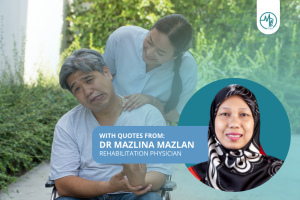Cord blood banking is the process of extracting stem cells from the cord blood, freezing them, and storing them. Cord blood is a source of stem cells, which can potentially be collected and stored for future uses. Stem cell transplant using cord blood is used to treat over 80 blood disorders.
Find out more about cord blood banking, why it is so important, and how much it usually costs from Dr Teo Cheng Peng, Senior Consultant Haematologist from StemCord Pte Ltd!
PSA: Medical Channel Asia (MCA) is now on Telegram! Join us here for daily reads and the latest updates at your fingertips!
Q1: What is cord blood banking?
Dr Teo: Extracting stem cells from cord blood, freezing it, and storing it
Q2: What is so special about cord blood?
Dr Teo: Although our bone marrow does contain stem cells, there are big differences between them. Advantages of collecting cord blood include:
- Easier collection: less painful with no risk to the mother or the child as compared to collection from the bone marrow which requires a painful procedure
- Cord blood stem cells are more naive: fewer problems in terms of graft-versus-host disease
Q3: What are the purposes of storing and keeping stem cells from cord blood?
Dr Teo: Stem cells are currently being used for stem cell transplants. Stem cell transplants with cord blood stem cells can be used to treat over 80 types of diseases. This offers a chance to cure patients with these conditions.
Besides current uses, we are also interested in future uses. We can potentially use these stem cells for regenerative therapy. We may use cells from the cord blood that we have stored today for future cell and gene therapy, which can be used against a variety of cancers and chronic infections (e.g. HIV and hepatitis B).
Q4: Can stem cells taken from a child (through the cord blood) be used to treat disorders in the same child?
Dr Teo: This is a rather complicated question. There are some blood disorders that we can still use stem cell transplant as a form of treatment. An example will be aplastic anaemia. Cord blood stem cells offer a very good choice of a chance of cure.
But there are other blood disorders like thalassemia major and sickle-cell anaemia that we would not be able to use stem cell transplant as a form of treatment. This is because the disorder is already in the stem cells, so we are unable to use that unit of cord blood. However, if the cord blood units of the child’s siblings are stored, we can potentially use them as a form of therapy for the child.
- Autologous: transplant using the donor’s own stem cells
- Allogenic: transplant using stem cells from another donor
Q5: Since stem cells are so versatile, can we use stem cells to treat people outside of your family?
Dr Teo: Cord blood banking started from public cord blood banking, where units of cord blood from pregnant ladies are donated to the bank. Anyone in the public can use them.
What is more interesting is what I consider family cord blood banking. In the last 10 to 15 years, there are more examples of how that unit of cord blood can be useful for siblings, parents, and even grandparents (what I refer to as ‘three-generation usage’). Other than stem cell transplant, what is more, interesting is using cord blood from the grandchild for the grandparents using regenerative therapy. There are current studies that are looking at using cord blood from the grandchildren for the management of strokes in the grandparents.
Q6: Has the use of cord blood been proven to work, since it is a fairly new form of therapy in the market?
Dr Teo: Of course! If you are talking about stem cell transplant, it is proven beyond doubt. It does help to cure over 80 types of diseases (ranging from blood cancers to blood disorders). Nowadays we can use cord blood as a form of regenerative therapy to treat cerebral palsy, autism, and even stroke.
With regards to using cord blood transplants to cure HIV, we have to balance and manage the expectations. The article in the New York Times published in February 2022 had a fairly dramatic headline, mentioning cord blood transplant curing a certain lady with HIV. Although this report may be true, there may be a few caveats to it: (1) Much research is still needed to confirm this, and (2) this could be simply a coincidence that the transplant used a unit of cord blood that has the CCR5-Δ32 gene mutation, which confers natural resistance to HIV. Unfortunately, this gene mutation is not common, happening in only 1% of the worldwide population. It is to be noted that the lady had the transplant NOT for HIV, but actually for a type of blood cancer called acute myeloid leukaemia (AML). My recommendation is to still go for the usual treatment and not consider a cord blood transplant as a form of treatment.
Q7: Is it painful to obtain and collect cord blood?
Dr Teo: It is absolutely not painful. We will only collect the cord blood when the child has been safely delivered and the mother is in a safe condition. Thereafter, we will clean the entire cord, sterilise it, and insert the needle to allow for the cord blood to flow into the bag for collection.
Q8: Can everyone have their cord blood donated? Are there any risks involved in this procedure?
Dr Teo: In theory, everyone can collect their own cord blood unit. For autologous storage, the question to answer is this: is the cord blood collected useful for the child and/or the family?
For public cord blood banking, the criteria get more stringent as the health authorities need to be sure that the unit of cord blood is absolutely safe to be donated to someone else.
There are no risks involved in this procedure.
Q9: Where does the cord blood go after collection? Does the method of storage matter?
Dr Teo: The cord blood collected will be delivered to our bank for processing. There are many banks that can do it. The differences between the banks lie in the standards and features that a particular bank will undertake. At StemCord, we go for the most stringent accreditation, which is the Foundation for the Accreditation of Cellular Therapy (FACT). We are the first in South East Asia to do it. Not many banks are willing to use this accreditation because it is very difficult to obtain.
Secondly, at StemCord, we store each unit in 2 bags in 2 different locations. This is to ensure that there will be an alternative and backup for these precious and useful stem cells, in the event that something happens to one location. Also, by storing in 2 separate bags, we can potentially even use the same unit of cord blood for 2 uses instead of just 1.
Q10: After the cord blood is stored, how long can it be kept?
Dr Teo: If the storage has been done properly (i.e. storage conditions are according to international standards), it can actually be stored forever. Studies have shown the survival of these stem cells even after 18 years!
Q11: When is the right time to consider the procedure?
Dr Teo: The mother or couple can make the decision any time, even up to the very last minute. However, if the mother or couple decides on the day the mother gets into labour, sometimes the blood may not be able to be collected properly, and you are more likely to miss the opportunity of collecting the cord blood.
Our suggestion is for the mother or couple to find out more about cord blood banking the moment the lady is pregnant, and make a decision by mid-trimester. This ensures that you have more time for preparation and collection.
Q12: How much does it cost?
Dr Teo: At StemCord, we have a few packages that cater to the different needs of the parents or even grandparents. The annual storage fee is SGD275 per year.
Conclusion
Cord blood banking is an option for parents to preserve the blood of the umbilical cord of their baby, to help with possible future medical needs. It can also be used for other individuals within the family, in the case of private cord blood banking; or for the general public, in the case of public cord blood banking. Aside from the treatment of bone marrow diseases, there is even potential for cellular and regenerative therapy in the use of cord blood stem cells.
Cord blood banking is a personal decision to be made by you and your family. Speak to your doctor and gather resources about cord blood banking. Be sure to understand what cord blood banking entails and you can make an informed decision.











